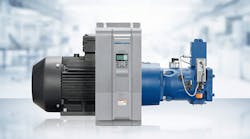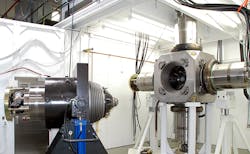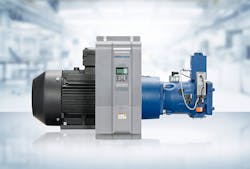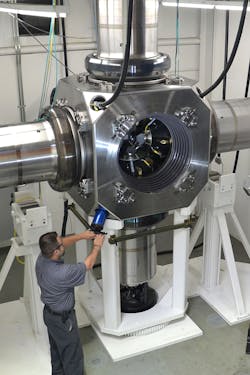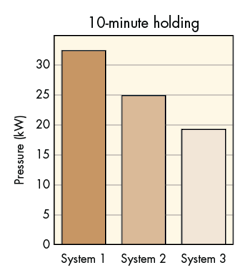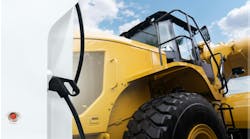Supermaterial Press Improves Efficiency with Variable-Speed Pump Drive
This file type includes high resolution graphics and schematics when applicable.
Creating supermaterials, such as synthetic diamonds and super-hard metals, requires a super-powerful press. The press must be able to apply extreme pressures and temperatures—like those produced deep within the earth—to source materials such as graphite or diamond powders to trigger a series of complex chemical and mechanical transformations.
Supermaterial press technology has been the bailiwick of Novatek Inc., Provo, Utah, for more than 60 years. In fact, the company’s current four-kiloton solid-frame presses incorporate some of the most advanced press technology in the industry. Nonetheless, Novatek still sought to achieve more energy efficiency and flexibility, and turned to Bosch Rexroth’s Sytronix DFEn variable-speed pump drive system to deliver the hydraulic power for its two newest presses.
Novatek built and operates ten four-kiloton, six-axis presses, creating supermaterials for applications ranging from drill bits to medical implants. Each press consists of a large, solid, cube-shaped alloy frame, 49.5 in. on each side, weighing 7.25 tons and mounted on a custom base. Six hydraulically driven cylindrical cartridges are positioned around all sides of the cube frame; each cartridge is tipped by a tungsten-carbide anvil.
During operation, a specially created cubic workpiece called a cell is placed in the center of the press. This cell, measuring 17.25 in.3, contains raw materials embedded in a pyrophyllite shell. With the raw materials inside, the cell is then compressed, crushed, and transformed by all six cylinder cartridges at once.
All six cylinders, which weigh nearly 9,000 lb each, contain proprietary Novatek technology and are driven into the center of the press by hydraulic pressure. They’re synchronized to meet within a few thousandths of an inch of each other as they precisely crush the work piece in a controlled manner.
As the work piece is compressed, a powerful electrical current simultaneously heats the cube up to 4,100° F. The combination of heat and pressure completes in 20 minutes what nature and time take millennia to achieve.
According to Michael Hall, head of production and process engineering at Novatek, one of the most challenging aspects of these presses is the rapidly changing demands on the hydraulic pump that’s driving the press.
“With these presses, in the first part of the cycle, we’re moving six large masses—the cylinders—many inches at high speed, under no load; there is no load until all six anvils meet and begin crushing the cube,” said Hall. “As this happens, everything’s going to slow down, but the compression from the cylinders is going up to eight million pounds, and we have to hold that, with no demand for flow, for an extended period.”
New Approach to Supplying Hydraulic Power
Eight of the presses, built since 1999, use hydraulic power units featuring conventional Bosch Rexroth components, including a 250cc A4VSO axial piston pump driven by an electric motor, proportional control valves, and a DRG pressure controller. Once the duty cycle on the press is initiated, the axial piston pump operates at a constant speed of 1800 rpm.
This equipment was provided to Novatek through Bosch Rexroth distributor partner Womack Machine Supply Co., Dallas, Texas. According to Womack Account Manager Riley Baker, when Novatek began planning two new presses, Womack and Bosch Rexroth had the opportunity to consider a more innovative hydraulic power solution.
“Novatek supplied us with a lot of data about the sequence of the machine, and how the press closed up and held for long periods of time,” said Baker.
Andrew Binversie, Bosch Rexroth sales manager for series presses, said their assessment indicated significant electric-power savings was possible with the Sytronix variable-speed pump drive system.
“When the press was holding pressure for 20 to 30 minutes, the total flow that accumulated on the pump, including leakage, was less than seven gallons a minute,” he said. “With that low of a flow and for that length of time, a variable-speed pump drive made perfect engineering sense.”
Unique Duty Cycle Prompts Sytronix Solution
Novatek’s presses undergo a unique duty cycle that rapidly shifts demand on the hydraulics power supply:
• The cycle begins with high hydraulic flow rates of 66 gpm (gallons per minute) at a drive speed of 2000 rpm, yielding essentially zero pressure to move the six massive cylinders to within a few thousandths of an inch of the target cell cube.
• Next, it briefly transitions to a period of high flow and high pressure when the proprietary intensifiers in the cylinders initiate the high-pressure crushing of the cube. The pump continues to deliver flow and follows a power curve prescribed in the Sytronix DFEn pump. As the flow demand decreases due to the load pressure, a speed command from the pump changes the motor speed from 2,000 rpm to 300 rpm. Near the end of this mode, pressure approaches 4,000 psi.
• Finally, there’s a holding, or “dwell,” phase with high pressure. This portion of the cycle is held at pressures of 4,500 psi and a drive speed of 300 rpm and nearly no flow, as 1,000 to 2,000 amps of 60-Hz ac power heats the cube. This phase can last from five up to as long as 30 minutes, depending on the supermaterial being produced.
Bosch Rexroth and Womack concluded that the Rexroth Sytronix DFEn variable-speed pump drive system offered the potential to save energy, reduce heat in the hydraulic system, and provide a more efficient hydraulic power source.
The Sytronix DFEn system is designed for high-pressure and high-flow applications such as Novatek’s presses. Rather than run a larger pump at a fixed rate, a variable-speed servo drive controls an electrohydraulically driven variable-displacement axial piston pump. Sensors detect the current system pressure and the pump adjustment, and transfer these values to the pump-integrated digital controller.
After matching the current actual values with the target values transmitted by the press control, the Sytronix DFEn control calculates the optimal pump speed for the entire press cycle. This increases speed to maximum for the high-flow/high-pressure portion of the cycle, then decreases speed (and thus power consumption) during the press dwell phase.
The variable-speed pump drive system can reduce energy consumption up to 80% compared to conventional fixed-displacement pumps. It’s also been shown to reduce the hydraulic power unit’s average noise emission by up to 20 dBA to help meet noise-control regulations and reduce soundproofing expenses.
The Sytronix control comes via Rexroth’s IndraDrive C HSC03 converter, a compact drive with integrated power supply and extremely high overload capacity engineered for single-axis applications such as the Sytronix DFEn system.
According to Binversie, Novatek initially wanted to explore using a third-party control for the pump drive. However, when Bosch Rexroth demonstrated its IndraWorks programming and drive-commissioning software, and how easy and intuitive it was to program the IndraDrive C drive, the company was enthusiastic about using the Rexroth drive.
Multiple Efficiencies in Press Operation, Equipment
“Since our presses switch almost instantly from extremely high flow and no pressure, to high pressure and low flow, I think that Sytronix is the best solution we’ve seen toward handling this challenge,” said Novatek’s Hall. “With the variable-speed drive and variable-displacement pump, it can clearly handle a wider envelope than conventional systems.”
When proposing Sytronix to Novatek, Rexroth engineers analyzed the potential energy savings compared with continued use of the previous hydraulic power unit. Based on an assumed use of 5,000 hours per year, it was determined that the DFEn solution could potentially reduce power consumption by nearly 50% annually.
The Sytronix system is also helping Novatek reduce waste heat from the hydraulic power unit, and thus the demands on the plant’s cooling systems. On their own, the four-kiloton presses generate significant amounts of heat. However, since the electric motor runs at a minimum during the dwell portion of the cycle, the Sytronix system generates less heat. Plus, it has fewer components and takes up less space than the previous system.
Another key factor is the Sytronix DFEn system uses the same Rexroth A4VSO axial piston pump currently employed on the other presses, but with a smaller, more efficient displacement.
“We realized, in the high-flow portion of the cycle, that they weren’t using the full capacity of the 250cc pump,” said Rexroth’s Binversie. “The 125-cc pump in the new system gives us enough flow to do the job, without having to bump up to the next pump size.”
Innovation Drives Next-Gen Presses
Once Bosch Rexroth and Novatek laid out the efficiency and performance advantages of the Sytronix DFEn system, Novatek quickly came on board. “We’re an innovation company,” said Hall. “The manufacturing footprint and the presses we have are there for us to develop new technologies, new materials, and processes. We believe our presses are state-of-the-art, truly the best in the world. So, we’re eager to incorporate innovative technology like Sytronix to be part of our machines and our process.”
This file type includes high resolution graphics and schematics when applicable.
